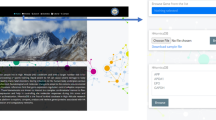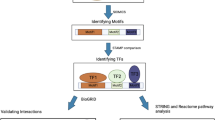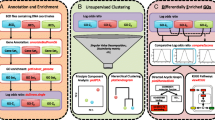Abstract
Hypoxia-inducible factor-1α (HIF-1α) has crucial role in adapting cells to hypoxia through expression regulation of many genes. Identification of HIF-1α target genes (HIF-1α-TGs) is important for understanding the adapting mechanism. The aim of the present study was to collect known HIF-1α-TGs and identify their associated pathways. Targets and associated genomics data were retrieved using PubMed, WoS (http://apps.webofknowledge.com/), HGNC (http://www.genenames.org/), NCBI (http://www.ncbi.nlm.nih.gov/), Ensemblv.84 (http://www.ensembl.org/index.html), DAVID Bioinformatics Resources (https://david.ncifcrf.gov/), and Disease Ontology database (http://disease-ontology.org/). From 51 papers, we collected 98 HIF-1α TGs found to be associated with 20 pathways, including metabolism of carbohydrates and pathways in cancer. Reanalysis of genomic coordinates of published HREs (hypoxia response elements) revealed six polymorphisms within HRE sites (HRE-SNPs): ABCG2, ACE, CA9, and CP. Due to large heterogeneity of results presentation in scientific literature, we also propose a first step towards reporting standardization of HIF-1α-target interactions consisting of ten relevant data types. Suggested minimal checklist for reporting will enable faster development of a complete catalog of HIF-1α-TGs, data sharing, bioinformatics analyses, and setting novel more targeted hypotheses. The proposed format for data standardization is not yet complete but presents a baseline for further optimization of the protocol with additional details, for example, regarding the experimental validation.


Similar content being viewed by others
References
Balazsi G, van Oudenaarden A, Collins JJ. Cellular decision making and biological noise: from microbes to mammals. Cell. United States: Elsevier, 2011. vol 144, pp 910–925.
Latchman DS. Transcription factors as potential targets for therapeutic drugs. Curr Pharm Biotechnol. 2000;1:57–61.
Georges AB, Benayoun BA, Caburet S, Veitia RA. Generic binding sites, generic dna-binding domains: where does specific promoter recognition come from? Faseb J. 2010; 24, pp 346–356.
Wang J, Lu J, Gu G, Liu Y. In vitro dna-binding profile of transcription factors: methods and new insights. J Endocrinol England, 2011 Society for Endocrinology. 2011;210:15–27.
Farnham PJ. Insights from genomic profiling of transcription factors. Nat Rev Genet England. 2009;10:605–16.
Pan Y, Tsai CJ, Ma B, Nussinov R. Mechanisms of transcription factor selectivity. Trends Genet England. 2010;26:75–83.
Kim TM, Park PJ. Advances in analysis of transcriptional regulatory networks. Wiley Interdiscip Rev Syst Biol Med. 2011;3:21–35.
Ke Q, Costa M. Hypoxia-inducible factor-1 (hif-1). Mol Pharmacol. 2006;70:1469–80.
Lee JW, Bae SH, Jeong JW, Kim SH, Kim KW. Hypoxia-inducible factor (hif-1)alpha: its protein stability and biological functions. Experimental and. Mol Med. 2004;36:1–12.
Maxwell PH, Wiesener MS, Chang GW, Clifford SC, Vaux EC, Cockman ME, Wykoff CC, Pugh CW, Maher ER, Ratcliffe PJ. The tumour suppressor protein vhl targets hypoxia-inducible factors for oxygen-dependent proteolysis. Nature. 1999;399:271–5.
Majmundar AJ, Wong WJ, Simon MC. Hypoxia-inducible factors and the response to hypoxic stress. Mol Cell. 2010;40:294–309.
Ortiz-Barahona A, Villar D, Pescador N, Amigo J, del Peso L. Genome-wide identification of hypoxia-inducible factor binding sites and target genes by a probabilistic model integrating transcription-profiling data and in silico binding site prediction. Nucleic Acids Res. 2010;38:2332–45.
Comerford KM, Wallace TJ, Karhausen J, Louis NA, Montalto MC, Colgan SP. Hypoxia-inducible factor-1-dependent regulation of the multidrug resistance (mdr1) gene. Cancer Res. 2002;62:3387–94.
Zaka R, Dion AS, Kusnierz A, Bohensky J, Srinivas V, Freeman T, Williams CJ. Oxygen tension regulates the expression of ank (progressive ankylosis) in an hif-1-dependent manner in growth plate chondrocytes. J Bone Miner Res. 2009;24:1869–78.
Noman MZ, Desantis G, Janji B, Hasmim M, Karray S, Dessen P, Bronte V, Chouaib S. Pd-l1 is a novel direct target of hif-1alpha, and its blockade under hypoxia enhanced mdsc-mediated t cell activation. J Exp Med. 2014;211:781–90.
Semenza GL. Targeting hif-1 for cancer therapy. Nat Rev Cancer. 2003;3:721–32.
Brocato J, Chervona Y, Costa M. Molecular responses to hypoxia-inducible factor 1alpha and beyond. Mol Pharmacol. 2014;85:651–7.
Gee HE, Ivan C, Calin GA, Ivan M. Hypoxamirs and cancer: from biology to targeted therapy. Antioxid Redox Signal. 2014;21:1220–38.
Ferdin J, Nishida N, Wu X, Nicoloso MS, Shah MY, Devlin C, Ling H, Shimizu M, Kumar K, Cortez MA, Ferracin M, Bi Y, Yang D, Czerniak B, Zhang W, Schmittgen TD, Voorhoeve MP, Reginato MJ, Negrini M, Davuluri RV, Kunej T, Ivan M, Calin GA. Hincuts in cancer: hypoxia-induced noncoding ultraconserved transcripts. Cell Death Differ. 2013;20:1675–87.
Cannistraci CV, Ogorevc J, Zorc M, Ravasi T, Dovc P, Kunej T. Pivotal role of the muscle-contraction pathway in cryptorchidism and evidence for genomic connections with cardiomyopathy pathways in rasopathies. BMC Med Genet. 2013;6:5.
Yates A, Akanni W, Amode MR, Barrell D, Billis K, Carvalho-Silva D, Cummins C, Clapham P, Fitzgerald S, Gil L, Girón CG, Gordon L, Hourlier T, Hunt SE, Janacek SH, Johnson N, Juettemann T, Keenan S, Lavidas I, Martin FJ, Maurel T, McLaren W, Murphy DN, Nag R, Nuhn M, Parker A, Patricio M, Pignatelli M, Rahtz M, Riat HS, Sheppard D, Taylor K, Thormann A, Vullo A, Wilder SP, Zadissa A, Birney E, Harrow J, Muffato M, Perry E, Ruffier M, Spudich G, Trevanion SJ, Cunningham F, Aken BL, Zerbino DR, Flicek P. Ensembl 2016. Nucleic Acids Res. 2016;44:D710–6.
Geiger K, Leiherer A, Muendlein A, Stark N, Geller-Rhomberg S, Saely CH, Wabitsch M, Fraunberger P, Drexel H. Identification of hypoxia-induced genes in human sgbs adipocytes by microarray analysis. PLoS One. 2011;6:e26465.
Garayoa M, Martinez A, Lee S, Pio R, An WG, Neckers L, Trepel J, Montuenga LM, Ryan H, Johnson R, Gassmann M, Cuttitta F. Hypoxia-inducible factor-1 (hif-1) up-regulates adrenomedullin expression in human tumor cell lines during oxygen deprivation: a possible promotion mechanism of carcinogenesis. Mol Endocrinol. 2000;14:848–62.
Cormier-Regard S, Nguyen SV, Claycomb WC. Adrenomedullin gene expression is developmentally regulated and induced by hypoxia in rat ventricular cardiac myocytes. J Biol Chem. 1998;273:17787–92.
Nguyen SV, Claycomb WC. Hypoxia regulates the expression of the adrenomedullin and hif-1 genes in cultured hl-1 cardiomyocytes. Biochem Biophys Res Commun. 1999;265:382–6.
Guille MJ, Kneale GG. Methods for the analysis of dna-protein interactions. Mol Biotechnol. 1997;8:35–52.
Helwa R, Hoheisel JD. Analysis of dna-protein interactions: from nitrocellulose filter binding assays to microarray studies. Anal Bioanal Chem. 2010;398:2551–61.
Remes-Lenicov F, Jacobsen KX, Rogaeva A, Czesak M, Hadjighasem M, Daigle M, Albert PR. Frontiers in neuroscienceidentification of novel transcriptional regulators in the nervous system. In: Chattopadhyay A, editor. Serotonin receptors in neurobiology. Boca Raton: CRC, Taylor & Francis; 2007.
Taverner NV, Smith JC, Wardle FC. Identifying transcriptional targets. Genome Biol. 2004;5:210.
Johnson DS, Mortazavi A, Myers RM, Wold B. Genome-wide mapping of in vivo protein-dna interactions. Science. 2007;316:1497–502.
Mitchell PJ, Tjian R. Transcriptional regulation in mammalian cells by sequence-specific dna binding proteins. Science. 1989;245:371–8.
Kelly BD, Hackett SF, Hirota K, Oshima Y, Cai Z, Berg-Dixon S, Rowan A, Yan Z, Campochiaro PA, Semenza GL. Cell type-specific regulation of angiogenic growth factor gene expression and induction of angiogenesis in nonischemic tissue by a constitutively active form of hypoxia-inducible factor 1. Circ Res. 2003;93:1074–81.
Krishnamurthy P, Ross DD, Nakanishi T, Bailey-Dell K, Zhou S, Mercer KE, Sarkadi B, Sorrentino BP, Schuetz JD. The stem cell marker bcrp/abcg2 enhances hypoxic cell survival through interactions with heme. J Biol Chem. 2004;279:24218–25.
Gimm T, Wiese M, Teschemacher B, Deggerich A, Schodel J, Knaup KX, Hackenbeck T, Hellerbrand C, Amann K, Wiesener MS, Honing S, Eckardt KU, Warnecke C. Hypoxia-inducible protein 2 is a novel lipid droplet protein and a specific target gene of hypoxia-inducible factor-1. FASEB J. 2010;24:4443–58.
Wellmann S, Bettkober M, Zelmer A, Seeger K, Faigle M, Eltzschig HK, Buhrer C. Hypoxia upregulates the histone demethylase jmjd1a via hif-1. Biochem Biophys Res Commun. 2008;372:892–7.
Semenza GL, Jiang BH, Leung SW, Passantino R, Concordet JP, Maire P, Giallongo A. Hypoxia response elements in the aldolase a, enolase 1, and lactate dehydrogenase a gene promoters contain essential binding sites for hypoxia-inducible factor 1. J Biol Chem. 1996;271:32529–37.
Wang Y, Roche O, Xu C, Moriyama EH, Heir P, Chung J, Roos FC, Chen Y, Finak G, Milosevic M, Wilson BC, Teh BT, Park M, Irwin MS, Ohh M. Hypoxia promotes ligand-independent egf receptor signaling via hypoxia-inducible factor-mediated upregulation of caveolin-1. Proc Natl Acad Sci U S A. 2012;109:4892–7.
Liao SH, Zhao XY, Han YH, Zhang J, Wang LS, Xia L, Zhao KW, Zheng Y, Guo M, Chen GQ. Proteomics-based identification of two novel direct targets of hypoxia-inducible factor-1 and their potential roles in migration/invasion of cancer cells. Proteomics. 2009;9:3901–12.
Klein A, Flugel D, Kietzmann T. Transcriptional regulation of serine/threonine kinase-15 (stk15) expression by hypoxia and hif-1. Mol Biol Cell. 2008;19:3667–75.
Chen N, Chen X, Huang R, Zeng H, Gong J, Meng W, Lu Y, Zhao F, Wang L, Zhou Q. Bcl-xl is a target gene regulated by hypoxia-inducible factor-1{alpha}. J Biol Chem. 2009;284:10004–12.
Ke X, Fei F, Chen Y, Xu L, Zhang Z, Huang Q, Zhang H, Yang H, Chen Z, Xing J. Hypoxia upregulates cd147 through a combined effect of hif-1alpha and sp1 to promote glycolysis and tumor progression in epithelial solid tumors. Carcinogenesis. 2012;33:1598–607.
Zhang R, Wu Y, Zhao M, Liu C, Zhou L, Shen S, Liao S, Yang K, Li Q, Wan H. Role of hif-1alpha in the regulation ace and ace2 expression in hypoxic human pulmonary artery smooth muscle cells. Am J Physiol Lung Cell Mol Physiol. 2009;297:L631–40.
Grabmaier K, AdW MC, Verhaegh GW, Schalken JA, Oosterwijk E. Strict regulation of caix(g250/mn) by hif-1alpha in clear cell renal cell carcinoma. Oncogene. 2004;23:5624–31.
Wykoff CC, Beasley NJ, Watson PH, Turner KJ, Pastorek J, Sibtain A, Wilson GD, Turley H, Talks KL, Maxwell PH, Pugh CW, Ratcliffe PJ, Harris AL. Hypoxia-inducible expression of tumor-associated carbonic anhydrases. Cancer Res. 2000;60:7075–83.
Mukhopadhyay CK, Mazumder B, Fox PL. Role of hypoxia-inducible factor-1 in transcriptional activation of ceruloplasmin by iron deficiency. J Biol Chem. 2000;275:21048–54.
Eclov RJ. Mechanisms regulating the expression and function of mxr: pharmaceutical sciences and pharmacogenomics. Ann Arbor, University of California, San Francisco, 2013, Ph.D., pp 464.
Tak E, Lee S, Lee J, Rashid MA, Kim YW, Park JH, Park WS, Shokat KM, Ha J, Kim SS. Human carbonyl reductase 1 upregulated by hypoxia renders resistance to apoptosis in hepatocellular carcinoma cells. J Hepatol. 2011;54:328–39.
Benita Y, Kikuchi H, Smith AD, Zhang MQ, Chung DC, Xavier RJ. An integrative genomics approach identifies hypoxia inducible factor-1 (hif-1)-target genes that form the core response to hypoxia. Nucleic Acids Res. 2009;37:4587–602.
Khurana P, Sugadev R, Jain J, Singh SB. Hypoxiadb: a database of hypoxia-regulated proteins. Database (Oxford). 2013;2013:bat074.
Kaluz S, Kaluzova M, Stanbridge EJ. Rational design of minimal hypoxia-inducible enhancers. Biochem Biophys Res Commun. 2008;370:613–8.
Kimura H, Weisz A, Ogura T, Hitomi Y, Kurashima Y, Hashimoto K, D'Acquisto F, Makuuchi M, Esumi H. Identification of hypoxia-inducible factor 1 ancillary sequence and its function in vascular endothelial growth factor gene induction by hypoxia and nitric oxide. J Biol Chem United States. 2001;276:2292–8.
MoncaleanoVega J, Ariza F, Hern¢ndez A. Association of nos3 and hif1¦á gene polymorphisms with the susceptibility of broiler chickens to develop hypoxic pulmonary hypertension. American Journal of Hypertension Research. 2013;1:17–22.
Wang C, Yuan C, Zhang L, Wu C, Li N. Differential gene expression of phosphoglyceric kinase (pgk) and hypoxic adaptation in chicken. Sci China C Life Sci. 2007;50:335–42.
Zeller KI, Jegga AG, Aronow BJ, O'Donnell KA, Dang CV. An integrated database of genes responsive to the myc oncogenic transcription factor: identification of direct genomic targets. Genome Biol. 2003;4:R69.
Bovolenta LA, Acencio ML, Lemke N. Htridb: an open-access database for experimentally verified human transcriptional regulation interactions. BMC Genomics. 2012;13:405.
Pahl HL. Activators and target genes of rel/nf-kappab transcription factors. Oncogene. 1999;18:6853–66.
Tang S, Han H, Bajic VB. Ergdb: estrogen responsive genes database. Nucleic Acids Res. 2004;32:D533–6.
Pichiule P, Chavez JC, Schmidt AM, Vannucci SJ. Hypoxia-inducible factor-1 mediates neuronal expression of the receptor for advanced glycation end products following hypoxia/ischemia. J Biol Chem. 2007;282:36330–40.
Weinmann AS. Novel chip-based strategies to uncover transcription factor target genes in the immune system. Nat Rev Immunol. 2004;4:381–6.
Shim H, Lewis BC, Dolde C, Li Q, CS W, Chun YS, Dang CV. Myc target genes in neoplastic transformation. Curr Top Microbiol Immunol. 1997;224:181–90.
Stormo GD, Zhao Y. Determining the specificity of protein-dna interactions. Nat Rev Genet. 2010;11:751–60.
Cheng C, Shou C, Yip KY, Gerstein MB. Genome-wide analysis of chromatin features identifies histone modification sensitive and insensitive yeast transcription factors. Genome Biol. 2011;12:R111.
Hsu SD, Lin FM, WY W, Liang C, Huang WC, Chan WL, Tsai WT, Chen GZ, Lee CJ, Chiu CM, Chien CH, MC W, Huang CY, Tsou AP, Huang HD. Mirtarbase: a database curates experimentally validated microrna-target interactions. Nucleic Acids Res. 2011;39:D163–9.
Schodel J, Oikonomopoulos S, Ragoussis J, Pugh CW, Ratcliffe PJ, Mole DR. High-resolution genome-wide mapping of hif-binding sites by chip-seq. Blood. 2011;117:e207–17.
Xia X, Kung AL. Preferential binding of hif-1 to transcriptionally active loci determines cell-type specific response to hypoxia. Genome Biol. 2009;10:R113.
Xia X, Lemieux ME, Li W, Carroll JS, Brown M, Liu XS, Kung AL. Integrative analysis of hif binding and transactivation reveals its role in maintaining histone methylation homeostasis. Proc Natl Acad Sci U S A. 2009;106:4260–5.
Cassavaugh J, Lounsbury KM. Hypoxia-mediated biological control. J Cell Biochem. 2011;112:735–44.
Bertout JA, Patel SA, Simon MC. The impact of O2 availability on human cancer. Nat Rev Cancer. 2008;8:967–75.
Li Y, D Y. Cancer therapy by targeting hypoxia-inducible factor-1. Curr Cancer Drug Targets. 2010;10:782–96.
Patiar S, Harris AL. Role of hypoxia-inducible factor-1alpha as a cancer therapy target. Endocr Relat Cancer. 2006;13(Suppl 1):S61–75.
von Elm E, Altman DG, Egger M, Pocock SJ, Gotzsche PC, Vandenbroucke JP. The strengthening the reporting of observational studies in epidemiology (strobe) statement: guidelines for reporting observational studies. Epidemiology. 2007;18:800–4.
Little J, Higgins JP, Ioannidis JP, Moher D, Gagnon F, von Elm E, Khoury MJ, Cohen B, Davey-Smith G, Grimshaw J, Scheet P, Gwinn M, Williamson RE, Zou GY, Hutchings K, Johnson CY, Tait V, Wiens M, Golding J, van Duijn C, McLaughlin J, Paterson A, Wells G, Fortier I, Freedman M, Zecevic M, King R, Infante-Rivard C, Stewart A, Birkett N. Strengthening the reporting of genetic association studies (strega)--an extension of the strobe statement. Eur J Clin Investig. 2009;39:247–66.
Peters SP. Reporting and evaluating genetic association studies. Respir Res. 2009;10:109.
Hollenbach JA, Mack SJ, Gourraud PA, Single RM, Maiers M, Middleton D, Thomson G, Marsh SG, Varney MD. A community standard for immunogenomic data reporting and analysis: proposal for a strengthening the reporting of immunogenomic studies statement. Tissue Antigens. 2011;78:333–44.
Janssens AC, Ioannidis JP, van Duijn CM, Little J, Khoury MJ. Strengthening the reporting of genetic risk prediction studies: the grips statement. Eur J Hum Genet. 2011;19:833–6.
Gallo V, Egger M, McCormack V, Farmer PB, Ioannidis JP, Kirsch-Volders M, Matullo G, Phillips DH, Schoket B, Stromberg U, Vermeulen R, Wild C, Porta M, Vineis P. Strengthening the reporting of observational studies in epidemiology–molecular epidemiology (strobe-me): an extension of the strobe statement. Mutagenesis. 2012;27:17–29.
Saffery R, Gordon L. Time for a standardized system of reporting sites of genomic methylation. Genome Biol. 2015;16:85.
Pipan V, Kunej T. Initiative for standardization of the format of the next-generation sequencing (ngs) results. Discoveries. 2015;3:e44.
Urh K, Kunej T. Molecular mechanisms of cryptorchidism development: update of the database, disease comorbidity, and initiative for standardization of reporting in scientific literature. Andrology 2016;4(5):894–902.
Spiegelman BM, Heinrich R. Biological control through regulated transcriptional coactivators. Cell. 2004;119:157–67.
Luo W, Chang R, Zhong J, Pandey A, Semenza GL. Histone demethylase jmjd2c is a coactivator for hypoxia-inducible factor 1 that is required for breast cancer progression. Proc Natl Acad Sci U S A. 2012;109:E3367–76.
Author information
Authors and Affiliations
Corresponding author
Ethics declarations
Funding
This work was supported by the Slovenian Research Agency (ARRS) through the Research program (P4-0220).
Electronic supplementary material
Supplemental Figure 1
. Identified polymorphisms within HRE sites of four target genes. Sequence of the target genes: ABCG2 (A), ACE (B), CA9 (C), and CP (D). Biotype of identified polymorphisms within HRE sites (E). (DOCX 1512 kb)
Supplemental Table 1
. Collected data associated with 98 HIF-1α target genes. (XLSX 38 kb)
Supplemental Table 2
. Pathway analysis of HIF-1α downstream targets. (DOCX 17 kb)
Rights and permissions
About this article
Cite this article
Slemc, L., Kunej, T. Transcription factor HIF1A: downstream targets, associated pathways, polymorphic hypoxia response element (HRE) sites, and initiative for standardization of reporting in scientific literature. Tumor Biol. 37, 14851–14861 (2016). https://doi.org/10.1007/s13277-016-5331-4
Received:
Accepted:
Published:
Issue Date:
DOI: https://doi.org/10.1007/s13277-016-5331-4




